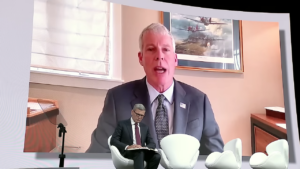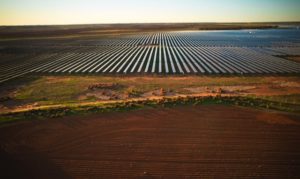South Australia – already leading the country, if not the world, with the amount of wind and solar in its electricity grid – could reach a level of 87 per cent renewables within four years, according to the latest scenarios published by the Australian Energy Market Operator.
The AEMO document outlines three core scenarios on how the South Australia generation mix could change over the next 10 years – a central scenario based on current policy settings and known investment commitments, a slow change based on slow economic growth and disinterest in emissions reduction, and a “step change” where real efforts and investment are made to reduce emissions.
South Australia already sources more than 50 per cent of its generation from wind and solar – the highest percentage of “variable” renewable sources in Australia by a long shot, and bettered only by Denmark in the world. South Australia, however, is at the end of a long skinny grid with a single connection to the neighbouring grid, putting its share of renewables at the world’s leading edge.
The AEMO report assumes that the state will source around 57 per cent of its generation from wind and solar in the current financial year, and dials in the addition of the Lincoln Gap battery, the second stage of the Lincoln Gap wind farm, and the retirement of several ageing gas units in coming years.
But it is the proposed new interconnector (Project Connect) to NSW from June 2023 that act as the “game-changer” for the state’s generation mix. Either way, the outlook for local gas generation is not good – it is either rapidly replaced by imports from NSW under the “central scenario” or replaced by big leaps of wind and large and small scale solar in the “step change” scenario.
In the step change scenario, the addition of the new interconnector encourages a massive amount of new build wind and solar, and an increased update of distributed energy resources (DER) that takes the share of wind and solar to 87 per cent of the state’s generation by 2023/24.
It relegates gas and diesel to a minor share of just 13 per cent, and with the level of imports and exports to Victoria and NSW about equal.
Over the following few years, the share of renewables continues to grow – about 1,200MW of large scale solar will be added and a further 1277MW in large scale wind.
This means that by the 2027/28 financial year, gas contributes little more than just 5 per cent of total generation in the state. Wind and solar provide the rest – augmented by big batteries and “virtual power plants” (linked household batteries), but with more than 20 per cent of their combined output being exported.
In other words, wind and solar will be producing much more than the state’s annual consumption needs, and the excess will be exported, with some imports (less than one half of the exports), and the gas generators providing “back-up” when needed. “South Australia ends up as a net exporter on its interconnectors for the last few years of the forecast,” the report says.
That puts the state well within the Liberal state government’s unofficial target of reaching “net 100 per cent” renewables by around 2030. it suggests its longer term targets of becoming a “net exporter” are also within reach in that time-frame.
Even in the slow change and central scenarios, gas only accounts for no more than 15 per cent of local generation by 2028/29. The difference with “step change” is that imports account for nearly one third of demand in slow change and central, while local wind and solar – and exports – make up the difference in step change.
Another interesting aspect of the Step change scenario is the growing impact of “virtual power plants” – currently being rolled out in the state-government’s Home Battery Scheme and other proposals. According to AEMO, VPPs could account for more than eight time the output of big batteries by 2028/29.
So much so that in the step change scenario AEMO notes that “consumer-led growth of storage creates such an abundance of VPP that its market utilisation begins to lag installed capacity.”
RenewEconomy and its sister sites One Step Off The Grid and The Driven will continue to publish throughout the Covid-19 crisis, posting good news about technology and project development, and holding government, regulators and business to account. But as the conference market evaporates, and some advertisers pull in their budgets, readers can help by making a voluntary donation here to help ensure we can continue to offer the service free of charge and to as wide an audience as possible. Thankyou for your support.













